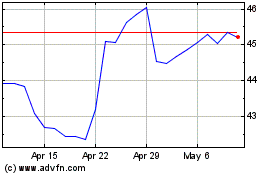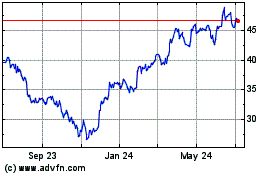Tesla Loss Widens But Beats Expectations -- Update
August 02 2017 - 6:01PM
Dow Jones News
By Tim Higgins
Tesla Inc.'s second-quarter loss was narrower than analysts'
expectations, buoying the Silicon Valley auto maker as it ramps up
production for its first all-electric sedan designed for a
mainstream audience.
The Palo Alto, Calif., company reported a loss of $336 million,
compared with a loss of $239 million a year earlier. On an adjusted
basis, the company's per-share loss of $1.33 beat the $1.82-a-share
loss predicted by a consensus estimate of analysts surveyed by
Thomson Reuters.
Revenue more than doubled to $2.79 billion, besting the
analysts' average projection of $2.51 billion.
Deliveries of the Model S sedan and Model X sport-utility
vehicle rose to about 22,000 during the quarter, a 53% gain from
the same quarter in 2016 but shy of 23,655, the average estimate of
analysts surveyed by The Wall Street Journal. The company has said
it expects sales in the second half of the Model S and Model X to
exceed the 47,000 vehicles it delivered during the first six months
of the year.
Tesla's shares were up 6.3% in after-hours trading to $346.54.
The stock has been on a tear this year, rising more than 50% amid
the enthusiasm for the Model 3 sedan, which Tesla moved into
production last month.
Investors and analysts have expressed concern that buyers'
anticipation for the $35,0000 Model 3 is eating into demand for the
Model S, which typically sells for around $100,000. But Tesla aimed
to calm those nerves on Wednesday in a letter to shareholders,
saying orders for both the large Model S sedan and Model X SUV have
been increasing leading up to and after a July 28 event during
which Chief Executive Elon Musk shared greater details about the
new smaller car.
"This growing demand gives us even more reason to expect
increased deliveries of Model S and Model X in the second half of
this year," Mr. Musk said in the letter.
At last week's event -- where Tesla celebrated the first 30
Model 3s being handed over to employee-buyers -- Mr. Musk said he
plans for the factory to reach a production rate of 500,000
annually next year. He is aiming to build 20,000 in December. Tesla
built about 84,000 vehicles in 2016.
Following the event, Tesla said it was averaging 1,800 Model 3
reservations a day.
Tesla said last week that nonemployee customers may receive the
first Model 3s in September or October. On Wednesday, Tesla said
deliveries to nonemployees will begin in the fourth quarter.
International deliveries will begin in late 2018, starting with
left-hand-drive markets, followed by right-hand- drive markets in
2019, according to Tesla.
The company didn't end up spending as much to prepare for
production of the Model 3 in the first half as expected. In May,
Tesla said it planned $2 billion in capital expenditures but ended
up spending $959 million in the second quarter after spending $553
million during the first. The lower-than-expected spending was
primarily because of the timing of milestone-based cash payments,
Tesla said.
Tesla expects to spend $2 billion during the second half as
those payments become due and as it expands its infrastructure.
While the company did boost spending to prepare for the Model 3, it
cut operating costs from the first quarter. The auto maker said it
faced a net-loss increase between quarters because of higher
currency costs.
Optimism for Tesla has helped propel the company's market value
this year above that of Ford Motor Co. and, at times, General
Motors Co.
But in recent weeks, Mr. Musk has worked to tamp down
expectations, warning fans at last week's event that the auto maker
was entering "manufacturing hell" for the next six months as he
ramps up assembly.
He said Friday the company has more than 500,000 reservations
for the Model 3 and reiterated that new orders wouldn't be filled
until late next year.
Mr. Musk is betting the arrival of the $35,000-base-price sedan
will help remake the company as a more mainstream auto maker,
ushering in an age of more affordable and popular electric
cars.
Pricing details revealed last week show that buyers can pay as
much as $59,500 for a version of the Model 3 with a long-range
battery and other premium features. The long-range Model 3 costs
$44,000 and can go 310 miles per charge, more than GM's Chevrolet
Bolt and more than the lowest-price Model S.
In many ways, the Model 3 is aimed at the buyers of BMW AG and
Daimler AG's Mercedes-Benz compact cars. The average transaction
price of an entry-level luxury car last month in the U.S. was
$41,831, while BMW's 3 Series sold on average for $43,023 and the
Mercedes-Benz C-Class sold for $48,571, according to researcher
Edmunds, which tracks new car sales.
Write to Tim Higgins at Tim.Higgins@WSJ.com
(END) Dow Jones Newswires
August 02, 2017 17:46 ET (21:46 GMT)
Copyright (c) 2017 Dow Jones & Company, Inc.
General Motors (NYSE:GM)
Historical Stock Chart
From Mar 2024 to Apr 2024

General Motors (NYSE:GM)
Historical Stock Chart
From Apr 2023 to Apr 2024
